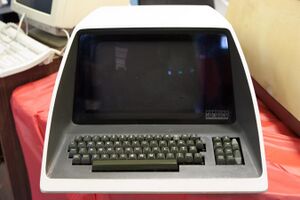Engineering:VT05
 | |
| Developer | Digital Equipment Corporation |
|---|---|
| Type | Video Terminal |
| Release date | 1970 |
| Successor | VT50 |
- "VT-05" can also refer to Vermont05 Vermont's 5th congressional district
.
The VT05 was the first free-standing CRT computer terminal from Digital Equipment Corporation introduced in 1970. Famous for its futuristic styling, the VT05 presented the user with an upper-case only ASCII character display of 20 rows by 72 columns.[1] The VT05 was a smart terminal that provided cursor addressing using a series of control characters, one of which allowed the cursor to be positioned at an absolute location on the screen.[1] This basic system provided the basis of similar systems in the later and greatly improved VT50 and VT52 series.[1]
The terminal only supported forward scrolling and direct cursor addressing; no fancier editing functions were supported. No special character renditions (such as blinking, bolding, underlining, or reverse video) were supported.[2] The VT05 supported asynchronous communication at baud rates up to 2400 bits per second (although fill characters were required above 300 bits per second).
Internally, the VT05 was implemented using four "quad-sized" DEC modules in a standard form-factor DEC backplane. The cards were mounted nearly horizontally over an off-the-shelf CRT monitor.[2] The terminal was 19" wide and 30" deep (much deeper than a typical desk).[1]
The keyboard used advanced capacitive sensors, but this proved to be unreliable and later keyboards used a simple four-contact mechanical switch.
The VT05's dynamic storage was a PMOS shift register; the delays associated with manipulating the data in the shift register resulted in the VT05 requiring fill characters after each line feed (as compared to contemporaneous hard copy terminals which required fill characters after each carriage return).[2]
The VT05 also had the capability of acting as a black-and-white RS-170-standard video monitor for videotape recorders, cameras, and other sources. The VT05 was equipped with a video input, and could superimpose its text over the displayed video, making it suitable for interactive video systems.
The VT05 was eventually superseded by the VT50 which itself was quickly superseded by the VT52.
Commands
The VT05 had a limited command set:
| Char | Code | Function |
| VT | 11 | Cursor down |
| SO | 14 | Move cursor. Followed by two characters encoding row and col, 32+Y and 32+X |
| CAN | 24 | Cursor left (not recommended) |
| EOM | 25 | Cursor right |
| SUB | 26 | Cursor up |
| FS | 28 | Home down, move to lower left corner |
| GS | 29 | Home up, move to upper left corner |
| RS | 30 | Erase to end of line |
| US | 31 | Erase to end of screen |
The screen could be cleared by sending GS and then US.[3]
References
- ↑ 1.0 1.1 1.2 1.3 "Digital's Video Terminals – VT100.net". http://vt100.net/dec/vt_history.
- ↑ 2.0 2.1 2.2 "VT05 Alphanumeric Terminal Reference Manual". http://vt100.net/docs/vt05-rm/.
- ↑ BASIC-PLUS Manual, DEC, 1972, p. 12-19, http://bitsavers.informatik.uni-stuttgart.de/pdf/dec/pdp11/rsts/V04/DEC-11-ORBPA-A-D_BASIC-PLUS_LangMan_Oct72.pdf
External links
- VT100 net
- DEC VT05, Terminals Wiki
- DEC VT05 terminal emulator for Windows, supports serial ports, telnet, and raw TCP: kgober/VT05, 2019-08-20, https://github.com/kgober/VT05, retrieved 2020-01-11

